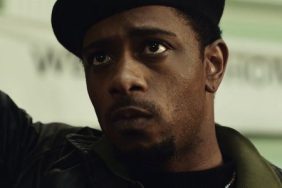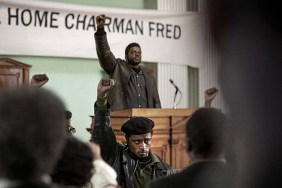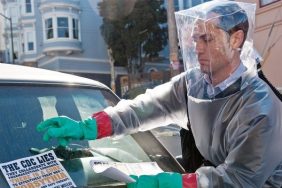Each week on Terror Cult, we here at CraveOnline introduce ignorant laypersons to the many winding and convoluted tributaries of the horror genre, focusing on subcults, subcategories, bizarre localized trends, and micro-micro subgenres. This week, through the haze of our Halloween hangover, we explore the fascinating and strange universe of bugnuts supernatural horror movies from Hong Kong, complete with flying heads, adultery-avenging sex demons, and maggot-infested dead baby carcasses.
Hong Kong’s film industry didn’t really hit its stride until the late ‘60s and early ‘70s, with the international rise in popularity of the Kung Fu film. The reason martial arts and Hong Kong remain so closely associated with each other today is because the explosion of that single generic microcosm was what initially boosted the previously modest local film industry to a position of worldwide prominence, particularly in coveted western markets.
The biggest and most important studio from Hong Kong’s golden era, the Shaw Brothers Studio, focused almost exclusively on the production of martial arts films, and their output comprises the vast majority of memorable period titles in that genre. In the ‘70s and early ‘80s, Shaw Studios started producing a string of horror titles inspired by folklore. Most of these movies offered a twisted, modernized take on ancient superstitions culled from the annals of Chinese and Cantonese mythology – sexual hypnotism, demon possession, necromancy, and revenge magic, among other sundries.
The Shaw Brothers’ output sparked beloved filmic tradition in Hong Kong that endures to the present day. Their sensibilities are manifest, in both subtle and abrasively impolite forms, in many of the local industry’s more recent genre offerings. The classic Hong Kong black magic films, meanwhile, remain beloved internationally by gorehounds and champions of oddball Psychotronia worldwide.
Black Magic (1975)

Quintessential of the subgenre it represents, Black Magic’s plot revolves around sexual jealousy and betrayal, and the ill-advised search for sexual domination through magical ritual. Setting up a host of enduring generic tropes, Black Magic follows the foibles of a spoiled, rich, and oversexed female antagonist who attempts to sabotage her co-worker’s marriage and brainwash him into becoming her sex slave. Like most Hong Kong movies, Black Magic features a truly epic and gloriously cheesy climactic sequence involving two black magicians duking it out at a construction site while precariously balanced on a perilous network of scaffolding.
The Killer Snakes (1975)

Reeking of 42nd Street grindhouses, The Killer Snakes is a grimy, porny psychodrama about an emotionally disturbed psychopath who discovers he has the ability to mentally control reptiles. Drowning in a mire of self-loathing and sexual frustration, he naturally harnesses his newfound power to launch a series of deranged, systematic assaults on a cornucopia of sexually brash ladies. Killer Snakes is a particularly sordid and sleazy entry in the Shaw Brothers horror canon, featuring plenty of involuntary softcore bondage, psychedelic superimposition footage, and of course, vagina snakes.
Seeding of a Ghost (1983)

Starting off fairly restrained, Seeding of a Ghost is most notable for its off-the-wall final ten minutes, featuring the unholy, blood-spurting birth of a razor-toothed, tentacle demon baby that rips apart an entire house full of party guests. Other remarkable sequences include the stop-motion mummified corpse seduction of a disembodied blue-lit captured spirit, and an unforgivably brutal sexual assault ending in a hideously grotesque fence post impaling. No doubt this movie is somehow cross-inspirationally related to John Carpenter’s The Thing, as well as the lo-fi ‘80s horror sci-fi oddity Deadly Spawn probably. Truly overflowing with insane, beautiful, cheesy imagery.
The Eye (2002)

The Eye was one of Hong Kong’s earliest modern, internationally successful horror offerings. Riding the coattails of other internationally successful necromancy films, The Eye is about a blind woman who, following a corneal transplant, discovers she is able to see, not just regular people and places, but the spirits of the walking dead. Though it’s a tightly structured and entertaining genre flick, The Eye draws much more deeply from contemporary Japanese horror films like Ringu, and American offerings like Sixth Sense and Stir of Echoes, than from local traditions. It does feature a few flourishes related to Hong Kong’s own supernatural traditions however, most notably from the Chinese “hungry ghost” concept and its expression, in folkloric parable, as literally consumptive spirits who appear seeking offerings of food or other essentials.
Dumplings (2004)

Extended from a shorter treatment featured in the Hong Kong horror anthology Three… Extremes, Dumplings features a much more subterranean supernatural dynamic than its predecessors, but anyone familiar with Hong Kong’s supernatural horror tradition can’t help but notice the thematic relationship. Seductively creepy lead actress Bai Ling plays a cannibalism-advocating ritual healer who makes a clandestine living cooking and serving fetus flesh to Hong Kong housewives desperate to retain their youthful sexuality. The film’s plot hinges on the psychological relationship between the fetus-peddler and a particular one of her clients, and this element of the movie particularly seems evocative of the Shaw Brothers tradition, which often focused on black magicians as figures of dark power and mystery. The practical value of Ling’s treatments is handled with a degree of ambiguity, but the movie’s raw skin-crawling quotient, its insidious cultural criticisms, and Ling’s compelling, award-winning performance all converge into a bitterly memorable experience.
Gong Tau: An Oriental Black Magic (2007)

More consciously referential of the old Hong Kong horror films is Gong Tau, also known in the United States as Voodoo. Gong Tau offers a more standardized blood-guts-and-flying-decapitated-heads storyline than Dumplings, more traditionally involving a black magician doling out supernatural punishment for adultery. It’s also so unbelievably loaded to the gills with gore, uncensored sexuality, and general maleficence that it earned a Category III seal, which is sort of like the Hong Kong equivalent of an NC-17. This one’s a little hard to find outside of its country of origin, but fans of extreme violence lucky enough to locate it definitely won’t be disappointed.
Be sure to return next week to Terror Cult, for more weird, terrifying, beautiful, and diversionary dissections of the horror genre.








